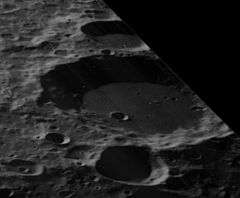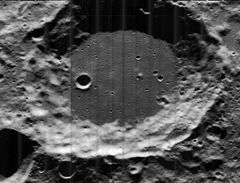Coulomb (crater)
|
Oblique Lunar Orbiter 5 image, facing west | |
| Coordinates | 54°42′N 114°36′W / 54.7°N 114.6°WCoordinates: 54°42′N 114°36′W / 54.7°N 114.6°W |
|---|---|
| Diameter | 89 km |
| Depth | Unknown |
| Colongitude | 116° at sunrise |
| Eponym | Charles A. Coulomb |

Coulomb is a lunar impact crater that lies behind the northwestern limb, on the far side of the Moon. It is located to the west-southwest of the large crater Poczobutt, and northeast of Sarton.
The rim of this crater is mildly eroded, but still retains a well-defined edge and displays some old terracing on the wide inner walls. The exterior of the crater also retains something of an outer rampart, extending for about a third of crater diameter. The satellite crater Coulomb V lies just beyond the west-northwest limb, while on the opposite side Coulomb J lies a short distance from the outer rim, forming a nearly symmetric pattern. The inner walls of the crater have only a few small impacts along the sides, with one near each of the aforementioned satellite craters.
Within the sloping inner walls, the crater floor is remarkably level and nearly featureless, at least in comparison to the more rugged terrain that surrounds the crater. Only a few tiny craterlets mark this interior plain, and a small crater near the south-southeast inner wall.
Coulomb lies within the Coulomb-Sarton Basin, a 530 km wide impact crater of Pre-Nectarian age.
Satellite craters
By convention these features are identified on lunar maps by placing the letter on the side of the crater midpoint that is closest to Coulomb.
| Coulomb | Latitude | Longitude | Diameter |
|---|---|---|---|
| C | 57.4° N | 110.8° W | 34 km |
| J | 53.1° N | 111.6° W | 35 km |
| N | 50.6° N | 115.8° W | 32 km |
| P | 50.5° N | 117.4° W | 38 km |
| V | 55.6° N | 118.1° W | 36 km |
| W | 56.5° N | 120.4° W | 34 km |
References
- Andersson, L. E.; Whitaker, E. A. (1982). NASA Catalogue of Lunar Nomenclature. NASA RP-1097.
- Blue, Jennifer (July 25, 2007). "Gazetteer of Planetary Nomenclature". USGS. Retrieved 2007-08-05.
- Bussey, B.; Spudis, P. (2004). The Clementine Atlas of the Moon. New York: Cambridge University Press. ISBN 978-0-521-81528-4.
- Cocks, Elijah E.; Cocks, Josiah C. (1995). Who's Who on the Moon: A Biographical Dictionary of Lunar Nomenclature. Tudor Publishers. ISBN 978-0-936389-27-1.
- McDowell, Jonathan (July 15, 2007). "Lunar Nomenclature". Jonathan's Space Report. Retrieved 2007-10-24.
- Menzel, D. H.; Minnaert, M.; Levin, B.; Dollfus, A.; Bell, B. (1971). "Report on Lunar Nomenclature by the Working Group of Commission 17 of the IAU". Space Science Reviews. 12 (2): 136–186. Bibcode:1971SSRv...12..136M. doi:10.1007/BF00171763.
- Moore, Patrick (2001). On the Moon. Sterling Publishing Co. ISBN 978-0-304-35469-6.
- Price, Fred W. (1988). The Moon Observer's Handbook. Cambridge University Press. ISBN 978-0-521-33500-3.
- Rükl, Antonín (1990). Atlas of the Moon. Kalmbach Books. ISBN 978-0-913135-17-4.
- Webb, Rev. T. W. (1962). Celestial Objects for Common Telescopes (6th revised ed.). Dover. ISBN 978-0-486-20917-3.
- Whitaker, Ewen A. (1999). Mapping and Naming the Moon. Cambridge University Press. ISBN 978-0-521-62248-6.
- Wlasuk, Peter T. (2000). Observing the Moon. Springer. ISBN 978-1-85233-193-1.
